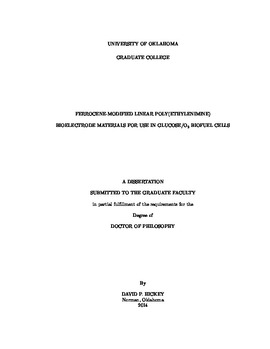| dc.description.abstract | Tetramethylferrocene-modified linear(polyethylenimine) (FcMe4-C3-LPEI) was cross-linked with ethylene glycol diglycidyl ether (EGDGE) in the presence of glucose oxidase (GOx) on carbon electrodes to form enzymatic redox hydrogels. These films have a direct practical application as enzymatic bioanodes, and as potential glucose biosensors. The amperometric response of FcMe4-C3-LPEI/GOx films to glucose was optimized by varying the amount of EGDGE, pH, and electrode material. The electrochemical potential varies with the amount of EGDGE used to cross-link the film, from 0.068 V to 0.122 V using 4 mol% to 32 mol% EGDGE respectively. A similar trend occurs with varying pH from 0.073 V at pH 4.0 to 0.118 at pH 8.0. A mathematical model was developed to account for this unique change in redox potential as a function of both pH and cross-linker concentration. Upon optimizing the degree of cross-linking and enzyme loading, current densities of 1.034 mA/cm2 with 3 mm glassy carbon electrodes and 15.1 mA/cm2 with 0.5x0.5 cm carbon felt electrodes were achieved at 0.13 V vs SCE in 2 M PBS at 25 C. Additionally, FcMe4-C3-LPEI is used to demonstrate a separate bioanode that is capable of extracting four electrons from a single molecule of sucrose by way of a three-enzyme cascade.
Invertase, fructose dehydrogenase and glucose oxidase were immobilized in a FcMe4-C3-LPEI hydrogel onto the surface of a carbon electrode. Fuel sources were generated in the polymer film by (1) hydrolyzing sucrose into fructose and glucose, and then (2) electroenzymatically oxidizing fructose and glucose to produce a current response. A previously unreported synergistic effect is observed between glucose oxidase and fructose dehydrogenase, that resulted in a limiting catalytic current density that was considerably higher than expected. The newly described enzyme cascade generated 302 uA/cm2 at 25 C and 602 uA/cm2 at 37 C, and when poised against an air breathing platinum cathode in a biofuel cell, the multienzyme-containing film generated 42 uW/cm2 at 0.17 mV with a maximum current density of 344 uA/cm2 in 100 mM sucrose at 25 C. This was the first example of an enzymatic biofuel cell that utilizes both fructose and glucose as oxidation fuel sources.
Finally, a novel chloroferrocene-modified redox polymer (FcCl-C3-LPEI) was synthesized, and shown to have a redox potential that is 0.1 V higher than its unchlorinated counterpart. This new redox polymer was used to immobilize the enzyme, laccase, to form an enzymatic biocathode (FcCl-C3-LPEI/laccase) capable of catalyzing the reduction of O2 to H2O. FcCl-C3-LPEI/laccase was capable of generating a maximum catalytic current density of 0.304 mA/cm2 on a 5 mm rotating disk electrode, and 3.54 mA/cm2 on a 0.5x0.5 cm carbon felt electrode at a potential of 0.42 V and at 25 C. The FcCl-C3-LPEI/laccase biocathode was poised against an optimized FcMe4-C3-LPEI/GOx bioanode to prepare a glucose/O2 biofuel cell able to achieve 636 uW/cm2 with a maximum current density of 3.43 mA/cm2 at 0.26 V and at 37 C. This is the first report of a biofuel cell to be mediated by ferrocene at both the anode and the cathode. | en_US |
